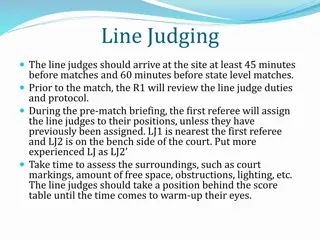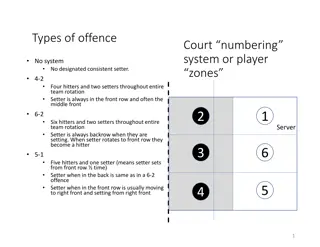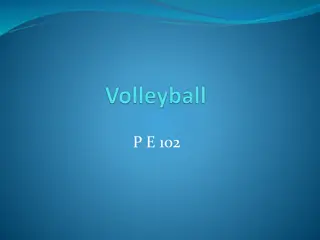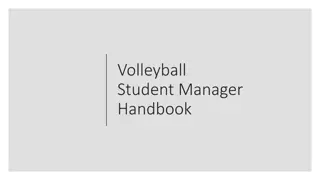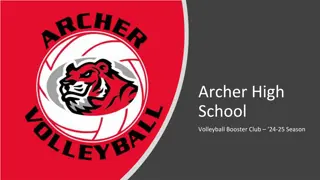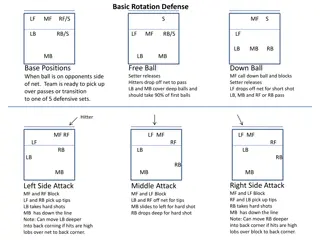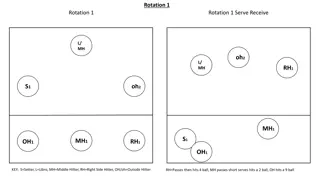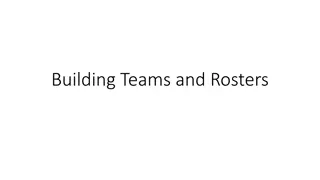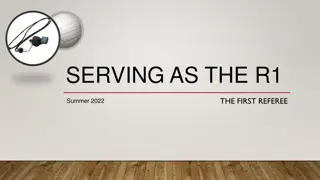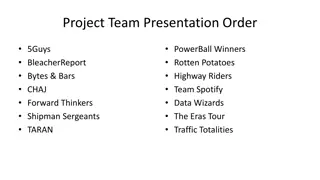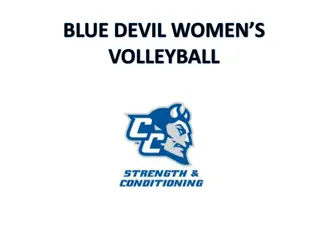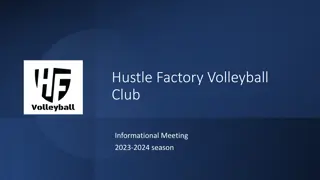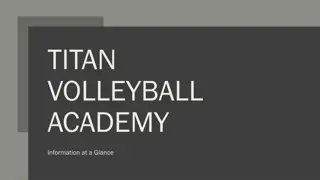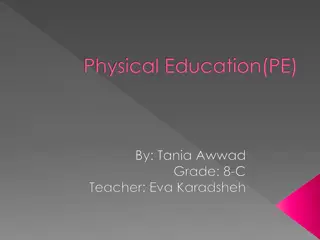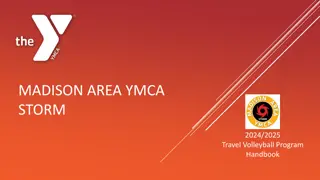Comprehensive Guide to Volleyball Programs and Regulations
This comprehensive guide covers various aspects of volleyball programs, including details about different programs offered, event descriptions, uniform requirements, equipment specifications, and team size regulations. It also provides insights into the season timeline, culminating events, and essential information for participants. From program names to specific rules for team composition and player attire, this guide offers a detailed overview for anyone interested in volleyball programs.
Download Presentation

Please find below an Image/Link to download the presentation.
The content on the website is provided AS IS for your information and personal use only. It may not be sold, licensed, or shared on other websites without obtaining consent from the author. Download presentation by click this link. If you encounter any issues during the download, it is possible that the publisher has removed the file from their server.
E N D
Presentation Transcript
Volleyball Program Name 1
The Basics Sport season: April - June Culminating State Events: State Summer Games 2 / Special Olympics Program Name
Events Offered Events Offered: Skills Team Competition Modified Team Competition Unified Team Competition 3
Uniform Program Name 4
Uniform 1.A volleyball uniform is a jersey, shorts, socks and shoes. 2.Kneepads are recommended. Players' jerseys must be numbered 1 to 99. 3.Numbers should be in the center on back and front of jersey. The numbers must contrast with the jersey color. 4.If undergarments, including but not limited to T-shirts, boxer shorts, tights, leotards, body suits, bicycle shorts, sports bras, etc., are worn so that they are exposed, they will be considered part of the uniform. In that case, they must be identical for any team member who wears such a uniform. Undergarments should be similar in color to uniform. 5.Hats, bandanas, du-rags, jewelry, and denim may not be worn during games or practice. Headbands, wristbands, and arm sleeves are acceptable. 6.Headwear for religious or medical reasons are acceptable but must be brought to the attention of the Games Director prior to competition. 5
Equipment Program Name 6
Equipment 1. Court size is 59 long by 29 6 wide (18M x 9M). 2. teams 2.43 meters (7ft, 11 5/8 inches) Female teams 2.24 meters (7' 4-1/8" feet) Unified Men & coed teams 2.43 (7ft, 11 5/8 inches) Unified Women teams 2.24 meters. The height of the net for team competition is Male & Coed 3. court size) inches from the net. The service line must be at least 14 feet 9 (28 feet full 4. ball should be between 25.6 & 26.4 inches in circumference and weigh no more than 9.1 - 9.8 ounces. It should be as close as possible to the regulation-size volleyball. A regulation size volleyball should be used. The size of the 7
Team Size Program Name 8
Team Size 1. than 12 players. You must have 6 players to start the set. You can finish with less than 6 but cannot start next match with less than 6. A team roster shall consist of at least seven players and no more 2. You may register 3 athletes as your team alternates. 3. All team members are required to play a match. 4. athlete who does not attend. When dropping an athlete prior to a SOMI Culminating Event or at the event site, only registered alternate athletes can be added. Awards are only given to team members listed on rosters and present the day of the event. (Ex. If you have 8 people listed on your original roster you can only bring 8 people to the event, if you drop one athlete they are replaced with one alternate.) It is strongly suggested to list alternate athletes. Alternates attend the event only when replacing a registered 9
Team Size Cont. 5. Each coach must see to it that each athlete has frequent opportunities to participate. 6. Unified Competition I. The roster shall contain a proportionate number of athletes and partners. II. During competition, the lineup shall never exceed three athletes and three partners at any time. III. Failure to adhere to the required ratio results in a forfeit. E IV. responsible for the lineup and conduct of the team during competition. Each team shall have an adult, non-playing coach 10
General Rules Program Name 11
General Rules 1. A player may not play the ball twice in succession except when blocking. 2. such contact, unless the ball crosses the plane of the net. Any ball hitting the ceiling will be considered playable by the team causing 3. has three plays to return the ball to the opponents. A served ball touching the net shall remain in play, and the receiving team 4. Substitutes I. A team will be allowed a maximum of 12 substitutions per set. II. one entry. Each player may enter the set three times. Starting the game constitutes as III. serving order in relation to their other teammates. This rule will be utilized in both regular and modified volleyball competition. players reentering the set must assume their original position in the 12
General Rules Cont. 5. Each team will get two timeouts per set 6. can be played only if it does not delay the start of the next scheduled match. Coaches and officials need to use their best judgment or play until the time is up. Coaches need to sign scorecards to verify results. If a team wins the first three sets of the match, the fourth game 7. right front player rotates to the right back position. The team receiving first service shall rotate upon the first side out. The first server of each set is the right back player. Thereafter, the 8. a specific side of the court. If a deciding third or fifth set is necessary, a coin toss shall again be conducted with the same options. The winner of the coin toss may choose to serve, receive or select 13
General Rules Cont. 9. The ball may be hit with any part of the body. 10. Touching any part of the net while playing the ball is a fault. Crossing completely over the centerline with any part of the body except the feet will not constitute a violation unless there is interference. It is a fault to cross completely over the centerline with the foot or feet. 11. Any ball landing on the line is considered in 14
Scoring Program Name 15
Scoring 1. be serving to score a point. All matches, including modified, will utilize Rally Scoring. You need not to 2. A match is won by the team that wins the best of three of five sets. 3. A playoff set is considered a match, and only one game will be played. 4. two-point advantage. In the case of a 24-24 tie, play is continued until a 2-point lead is achieved. A one-game match is won by the team that scores 25 or more points with a 5. tiebreaker with rally point scoring procedures to 15 points and no point cap. In the case of a 1-1 or 2-2 set tie, the deciding set (3rd or 5th) is played as a 6. Teams change sides when one team has scored eight points. 16
Scoring Cont. 7. the opponent wins the rally and scores the point. If a team fails to serve properly, return the ball, or commits any other fault, 8. serve. If the receiving team wins the rally, it scores a point and gains the right to serve. When the serving team wins a rally, it scores a point and continues to 9. State Office. Within a match there are sets; each set is played to 25 points except the deciding 3rd or 5th set, which is played to 15. Traditional division matches will play the best 3 out of 5 sets, with the winner being the team who wins three sets. Modified division matches will play the best 2 out of 3 sets, with the winner being the team who wins two sets. A match is equal to one full game, therefore 3 match scores are due to the Set 1 25 20 Set 2 22 25 Set 3 19 25 Set 4 25 18 Set 5 15 13 Winner X Team A Team B 17
Libero Player Program Name 18
Libero player 1. Any team has the option to designate two Libero players on its roster for each match. There are special rules if the Libero player is injured and cannot continue. Libero players are players that play defensive positions only. 2. sheet for the first set of the match, in addition to the numbers for the starting six players. The Libero jersey number(s) must be placed on the lineup 3. contrasting color and/or design than that of the rest of the team in order to be easily recognized on the court. The Libero player must wear a uniform of a different and 19
Libero Scoring Cont. 4. Libero playing actions: I. except in Unified Sports competition when an athlete may only replace an athlete and a partner replace a partner. The Libero is allowed to replace any player in a back-row position, II. allowed to complete an attack hit from anywhere (including playing court and free zone) if at the moment of the contact, the ball is entirely higher than the top of the net. He/she is restricted to perform as a back-row player and is not III. of the net if the ball is coming from an overhead finger pass by a Libero in his/her front zone. A player may not complete an attack hit from higher than the top IV. action from behind the front zone. The ball may be freely attacked if the Libero makes the same 20
Libero Scoring Cont. 5. Libero Replacements: I. counted as a substitution. When the Libero replaces a player in the back zone, it is not II. Libero replacements are unlimited. III. Libero. Only the players whom he/she replaced may replace the IV. Replacements may take place at the start of the set after the second referee has checked the lineup or while the ball is out of play, before the first referee blows the whistle for service. 21
Modified Team Competitions Program Name 22
Modified Team Competitions 1. inches (15 meters x 7 meters). The height of the net for modified team competition will be 7 feet 4-1/8 2. Games. The modified volleyball (32 inches & 8 ounces) will be utilized at Summer 3. One assist on a serve is allowed. 4. The serve line will be moved up to 14 9 (4.5 meters). 5. A time limit of 30 minutes may be set for each set. 6. their serve, there will be an automatic side out. A 3-point serving rule will be used. Once one player has scored 3 points on 7. Antennas will still be placed on the sideline of the smaller court. 8. Two of the three sets to 21 points will determine a match. 9. A team must win each sets by two points. 23
Unified Team Competitions Program Name 24
Unified Team Competitions 1. partners. The roster shall contain a proportionate number of athletes and 2. and three partners at any time. Failure to adhere to the required ratio results in a forfeit. During competition, the lineup shall never exceed three athletes 3. the lineup and conduct of the team during competition. Each team shall have an adult, non-playing coach responsible for 4. alternation of athletes and partners. The serving order and positions on the court, at service, shall be an 5. shall rotate to the next server and continue to serve. Once a server has scored three consecutive points, his/her team 25
Individual Skills Contest Program Name 26
Individual Skills Contest 1. athletes who have not yet developed the skills necessary to participate meaningfully in team competition and wheelchair athletes. The Individual Skills Contest is designed for lower ability or new 2. Athletes may not be assisted by coaches. 3. impairments. Modifications will be made for athletes who have visual or hearing 4. scores achieved in each of the events. The athlete's final score is determined by adding together the Volleyball Individual Skills Contest Overhead Passing Serving Passing (Forearm) 27
Individual Skills Contest Cont. Event #1 - Overhead Passing 1.Equipment: Use a regulation-size court that is 18 meters (59 feet) long and 9 meters (29 feet, 6 inches) wide, four volleyballs (modified ball permissible), net height at 2.24 meters (7 feet, 4 1/8 inches) for women and 2.43 meters (7 feet, 11 5/8 inches) for men, standards, antennae and ball box. 2.Description: Player is given 10 attempts from the center front position that is 2 meters (6 feet, 6 3/4 inches) from the net and 4.5 meters (14 feet, 9 inches) from the sideline. The player receives 10, two-handed, underhand-tossed balls from the tosser who is positioned in his/her backcourt, 4 meters (13 feet, 1 1/2 inches) from the baseline and 3 meters (9 feet, 10 inches) from the sideline in the left back position. The player sets the tossed ball toward a target (a person who has his/her hands above the head and who is standing 2 meters from the net and 2 meters from the sideline in the left front position). Tosses that are not high enough for the athlete to set are repeated. The goal is for the peak of the arc of each set ball to be above net height. Scoring: The peak of the arc of each set ball toward the target is measured. The athlete will receive one point for volleying/setting the ball 1 meter (3 feet, 3 1/3 inches) above his/her head height and three points for volleying/setting the ball above net height. The following result in zero points: illegal contact, balls which go lower than head high and balls which go over the net or outside the court. The athlete s final score is determined by adding together the points awarded for each of the 10 attempts. (It is suggested that the official stand on a chair to evaluate the height of each set). 28
Individual Skills Contest Cont. Event #2 Serving 1.Equipment: Use a regulation-size court that is 18 meters (59 feet) long and 9 meters (29 feet, 6inches) wide, five volleyballs (modified ball permissible), net, standards, antennae, measuring tape, floor tape or chalk and ball box. 2.Description: The athlete stands 1.5 meters inside the end line and serves 10 volleyballs, one at a time, into the opponent s court. 3.Scoring: The court is divided into three equal areas of 3 meters in width. Each of these areas is assigned a different point value. The athlete s score is the cumulative point total of the 10 serves. A ball which lands on the line is assigned to the area with the highest point value. 29
Individual Skills Contest Cont. Event #3 - Passing (Forearm) 1.Equipment: Use a regulation-size volleyball court that is 18 meters (59 feet) long and 9 meters (29 feet, 6 inches) wide, five volleyballs (modified ball permissible), net, standards, measuring tape, marking tape and ball box. 2.Description: The athlete stands at the right back position, 3 meters [9 10 ] from the right sideline and 1 meter [3 3 1/3 ] from the baseline. A ball is thrown, using a two hand, overhead toss by a coach/official who is standing on the same side of the net in the center front position, 2 meters (6 feet, 6 3/4 inches) from the net. The athlete receives the toss and passes the ball toward a target (a person who has his/her hands above the head and who is standing on the same side, 2 meters away from the net, and 4 meters [13 feet, 1 1/2 inches] from the sideline away from the tosser). Target areas of varying point values are marked on the front court. The event is repeated with the athlete at the left back position, 3 meters from the left sideline and 1 meter from the baseline. Scoring: The athlete must pass the ball so that the peak of the arc is at least net height in order to receive maximum points. A ball which lands on the line is assigned to the area with the higher point value. A ball which is passed below net height will receive only one point, regardless of where it lands. The athlete s final score is determined by adding together the points scored from his/her five attempts at both the right back and the left back positions. It is suggested that the official stand on a chair to evaluate the height of each pass. 31
Thank you. Program Name 32







